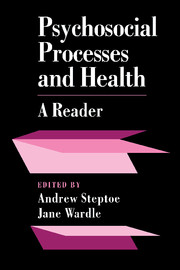Book contents
- Frontmatter
- Contents
- Preface
- Section 1 Life stress, social support and health
- Section 2 Psychophysiological processes in disease
- Pain mechanisms: a new theory
- Effects of coping behavior on gastric lesions in rats as a function of the complexity of coping tasks
- Social stress and atherosclerosis in normocholesterolemic monkeys
- Mental stress and the induction of silent myocardial ischemia in patients with coronary artery disease
- Depressed lymphocyte function after bereavement
- Psychological stress and susceptibility to the common cold
- Section 3 Personality, behaviour patterns and health
- Section 4 Health practices and the modification of health risk behaviour
- Section 5 Coping with illness and disability
- Section 6 Behavioural interventions in medicine
- Index
Pain mechanisms: a new theory
from Section 2 - Psychophysiological processes in disease
Published online by Cambridge University Press: 05 August 2016
- Frontmatter
- Contents
- Preface
- Section 1 Life stress, social support and health
- Section 2 Psychophysiological processes in disease
- Pain mechanisms: a new theory
- Effects of coping behavior on gastric lesions in rats as a function of the complexity of coping tasks
- Social stress and atherosclerosis in normocholesterolemic monkeys
- Mental stress and the induction of silent myocardial ischemia in patients with coronary artery disease
- Depressed lymphocyte function after bereavement
- Psychological stress and susceptibility to the common cold
- Section 3 Personality, behaviour patterns and health
- Section 4 Health practices and the modification of health risk behaviour
- Section 5 Coping with illness and disability
- Section 6 Behavioural interventions in medicine
- Index
Summary
Abstract
A gate control system modulates sensory input from the skin before it evokes pain perception and response.
The nature of pain has been the subject of bitter controversy since the turn of the century (1). There are currently two opposing theories of pain: (i) specificity theory, which holds that pain is a specific modality like vision or hearing, “with its own central and peripheral apparatus” (2), and (ii) pattern theory, which maintains that the nerve impulse pattern for pain is produced by intense stimulation of nonspecific receptors since “there are no specific fibers and no specific endings” (3). Both theories derive from earlier concepts proposed by von Frey (4) and Goldscheider (5) in 1894, and historically they are held to be mutually exclusive. Since it is our purpose here to propose a new theory of pain mechanisms, we shall state explicitly at the outset where we agree and disagree with specificity and pattern theories.
Specificity theory
Specificity theory proposes that a mosaic of specific pain receptors in body tissue projects to a pain center in the brain. It maintains that free nerve endings are pain receptors (4) and generate pain impulses that are carried by A-delta and C fibers in peripheral nerves (6) and by the lateral spinothalamic tract in the spinal cord (2) to a pain center in the thalamus (7). Despite its apparent simplicity, the theory contains an explicit statement of physiological specialization and an implicit psychological assumption (8, 9). Consider the proposition that the skin contains “pain receptors.” To say that a receptor responds only to intense, noxious stimulation of the skin is a physiological statement of fact; it says that the receptor is specialized to respond to a particular kind of stimulus. To call a receptor a “pain receptor,” however, is a psychological assumption: it implies a direct connection from the receptor to a brain center where pain is felt (Fig. 1), so that stimulation of the receptor must always elicit pain and only the sensation of pain. This distinction between physiological specialization and psychological assumption also applies to peripheral fibers and central projection systems (9).
- Type
- Chapter
- Information
- Psychosocial Processes and HealthA Reader, pp. 112 - 131Publisher: Cambridge University PressPrint publication year: 1994
- 9
- Cited by



